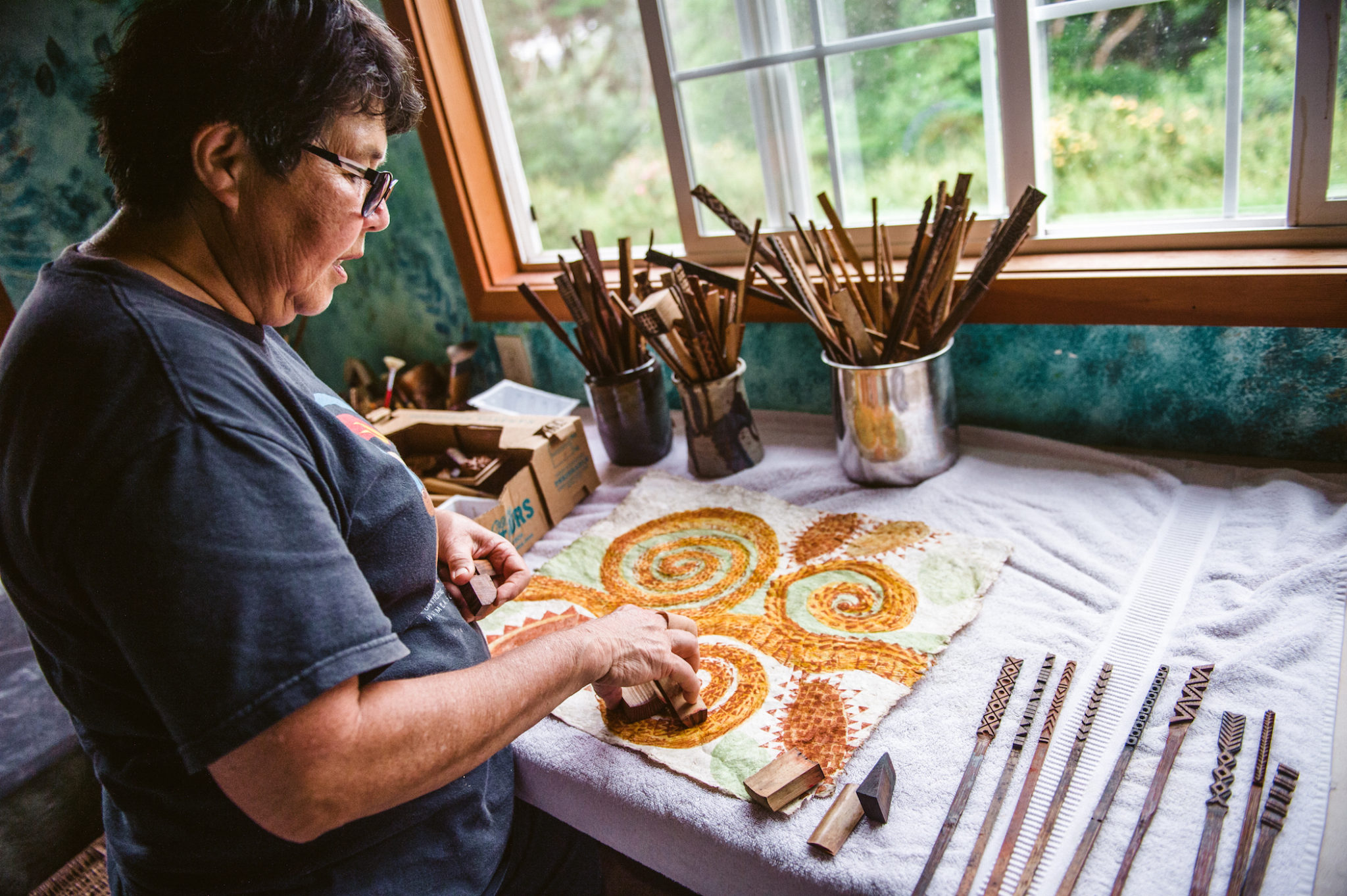Traditional cloth-making survives near extinction with the help of kapa artisans on Hawai‘i Island.
In Big Island’s Kamuela town, where cool breezes whoosh past lush grassy meadows, Roen Hufford walks the organic vegetable farm she and her husband operate. Her mother acquired it in 1978 with an agricultural lease to grow flowers, so wandering through the now food-producing farm is more like taking a stroll through the gardens of a colonial mansion. Along a path that winds through the lawn are lush ‘ohia, shady fern groves, brilliant clumps of flowering protea, and two large patches of wauke, used in making traditional Hawaiian kapa cloth. There’s the poa‘aha variety of wauke, with heart-shaped leaves and thick, felt-like bark, and mana lima, a taller variety.
In a single, swift motion, Hufford deftly harvests a stalk of poa‘aha using a tool gifted to her by a fellow kapa maker. Handmade from wood and shell, its barely audible scrape removes the outer bark of the plant with stunning precision and efficiency. Matching the curve of the niho ‘oki—a cutting tool made of shark teeth—to the curve of the stalk, Hufford runs it lengthwise, removing the “bast,” or inner bark, with a satisfying swish. The bast, which is the starting material of kapa cloth, is then rolled up and soaked in a bucket of saltwater to open up and bleach the fibers. Ancient Hawaiians would have placed it in a tidepool to accomplish the same effect.
In ancient times, women beat wauke every day to make kapa for loincloths, blankets, and other adornments. The pieces that came out rougher (determined by length of beating, precision, and tools) were worn by commoners. Other more embellished pieces were given to ali‘i, the royalty or nobility.
Everthing Hufford knows about kapa making was passed down to her by her teacher and mother, Marie MacDonald, a self-taught living master who began making kapa in 1948. At 88, MacDonald no longer actively pounds kapa, yet she remains among a select few responsible for a cultural renaissance in the transforming of wauke to cloth.
When the missionaries brought fabric to the islands, beating kapa diminished almost instantly. With the end of this culture, so too came the end of sharing and learning about how to beat kapa. MacDonald had taught herself simply because there was no one to teach her. Today, Hufford is grateful for the instruction of her mother in this art, which has allowed her the foundation that she is now learning—one that will enable her to expand in her own unique way.

“Every kapa maker has their favorite tools,” Hufford says. With each steady thump of the carved wooden hohoa (tapa beater) against pohaku (stone) or kua la‘au (wood), Hufford ensures that the tradition is carried on. After soaking, the bast will be beaten, dried, then wrapped to be preserved for later. That way, she can do the initial beating of several pieces while the weather is good, and re-soak them for second beatings another time. It’s an entirely physical, integrated process for Hufford, who seems to pound the wauke out of a literal necessity to keep her self-proclaimed “working hands” active. She says she doesn’t speak Hawaiian very well. Instead, the sounds—the swish of tools cutting bast and the hollow tap of hohoa on kua la‘au—are her language.
The finished product, resulting from several stages of pounding, is a thin sheet of cloth-like fiber that can be gently crinkled or rubbed with coral, stone, or shells to soften it further. In a small studio near her laundry room (“It’s very appropriate,” says Hufford, who sometimes dons the traditional cloth for special occasions), she prints her kapa cloth using natural dyes made from fruits, leaves, roots, and earth—a process also passed down from her mother.
Though Hufford has tried tools made by others, she always comes back to those of her mother. It’s a shared art for this mother-daughter duo, just as it would have been in ancient times. When people see her work, Hufford hopes they will inquire of her artistry, “Where can I find somebody who will show me how to do this?”
Hufford’s pieces have shown at Bishop Museum, Merriman’s, and the Wailoa Arts and Cultural Center, to name a few. However, she insists she’s not that talented, instead explaining that it’s really all about appreciating the history of this place. “What I like about [beating kapa] is this is transformed from that piece of bark I cut out there,” she says. “Then it gets transformed by beating on it, letting it get hot, and then adding color to it. And pretty soon it doesn’t look like anything it started out as.”
She continues, “These things are based in this land. If Kū, Kāne, Lono, and Kanaloa made this, why not make it beautiful? Why not adorn your body and say, ‘I’m part of this wonderful place that we live in?’”
This story is part of our Apocalypse Issue.

